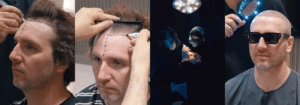Any type of hair structure can be transplanted. However, straight hair and thick hair are easier to transplant than thin hair and curly hair with a spiral shape.
There are approximately 30 different hair structures, categorised according to hair thickness and hair curliness.
Everybody has their own genetically inherited hair structure. It is the hair root that determines whether you have straight or wavy hair. Curly hair follicles are oval-shaped. If the hair root is round in shape, on the other hand, straight hair grows out of it.
Curly hair is a dominant dominant genetic characteristic. This means that if one of your parents has curly hair, then the structure of your own hair is also usually curly.
Curly haired patients are also more prone to suffering from traction alopecia, where tightly pulled back hair falls out. Typically, if you reduce how much you pull your hair, it will grow back on its own without needing hair restoration.
What role does the hair structure play in a hair transplant?

Hair structure plays a subordinate role in a hair transplant. You can transplant all healthy hair, including curly hair. It makes no difference whether the hair structure is curly or straight, thick or thin.
The influence of hair thickness on the hair transplant procedure
However, there are different degrees of difficulty. For example, thicker hair is easier to transplant than thin hair. You need to transplant fewer thick hairs because they provide a fuller result with fewer grafts per square centimetre.
Blonde hair appears fuller more quickly than darker hair because it contrasts less with the scalp. In this case, however, you can use scalp pigmentation to fill in the thinning areas, allowing you to avoid transplanting more grafts even with dark hair.
Hair type and transplantation

When transplanting curly hair, the surgeon must implant the individual grafts at the right angle to ensure the curls lie correctly later. If you look at natural curls, you will see that not every single hair is particularly wavy, but whole groups of hair have the same wave shape.
Transplanting extremely curly hair is another challenge. The follicles of such hair grow slightly curved under the scalp. Even hair transplantation with the FUE (Follicular Unit Extraction) or DHI (Direct Hair Implantation) methods can be tricky.
This is particularly the case if the hair transplant surgeon is inexperienced. That is why people with curly hair should pay extra attention in their choice for an experienced hair transplant surgeon for their hair restoration surgery.
Other, older, hair transplant surgeries such as FUT (Follicular Unit Transplantation) can also be used, but leave more of a scar in the donor area from which the hair grafts are harvested
Due to the complexity of the procedure, the costs of a hair transplant often increase. Cosmedica Clinic includes these services in the package price, so you do not have to worry about costs increasing depending on the structure of your hair.
Does the structure of the hair change after a hair transplant?

The hair structure does not change after hair transplantation. Hair from the donor area will nearly always have the same structure as in the recipient, balding area.
The FUE hair transplant technique transplants individual follicular units, ensuring that the hairs continue to grow normally after the procedure. You will not notice any difference between your curly transplanted hair and your normal curly hair.
If you notice a change in the hair structure after a hair transplant, please contact us so that we can understand the cause.
FAQ
Yes, any type of healthy hair can be transplanted. The procedure is generally easier with straight or thick hair. Complexities are higher with thin or curly hair, requiring skilled surgical expertise.
No, the hair structure remains the same post-transplant. Hair from the donor area retains its original properties when transplanted to the balding area, continuing to grow naturally without noticeable differences.
Thicker hair is easier to transplant and fewer grafts are needed, providing a fuller result per square centimetre. Thin hair requires more grafts to achieve the same density, increasing the procedure’s complexity.
Yes, curly hair demands more experience from the surgeon. It requires correct angle implantation for curls to lie naturally. Extreme curls and under-skin follicle curvature add to the complexity, necessitating an experienced surgeon.
If you notice any changes in hair structure after your transplant, contact us immediately. The transplanted hair should maintain its original characteristics, and any changes could indicate an issue needing resolution.




